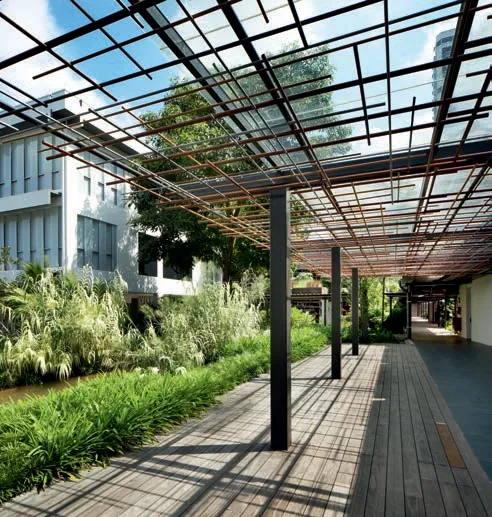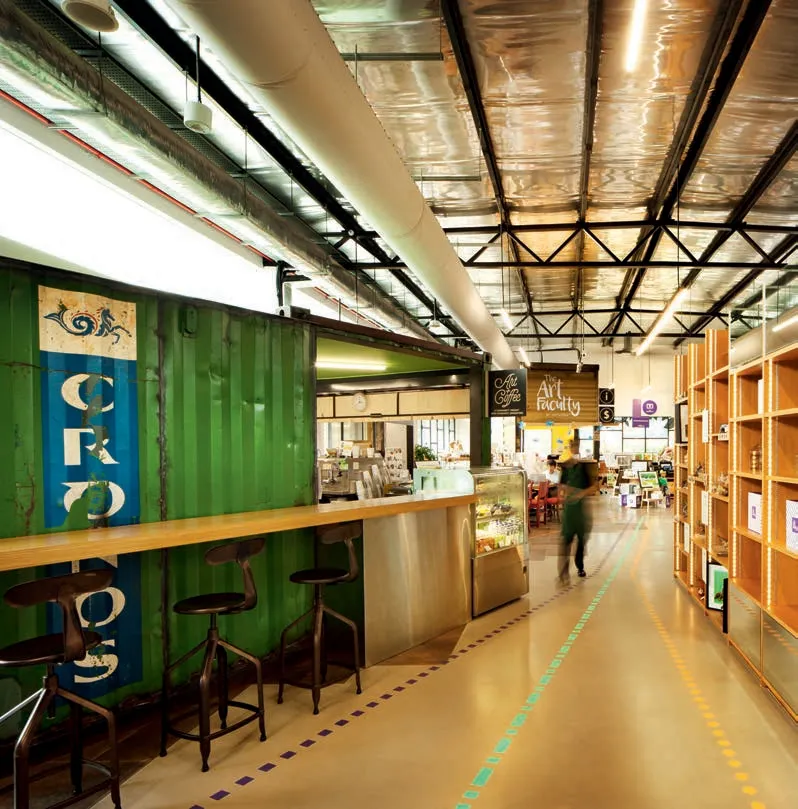新协立综合社区服务中心,红山路,新加坡
2020-04-02王单单

1
1 鸟巢与花园小屋视觉上锚定了生态池/Nest block and garden cabanas visually anchors the biopond
该项目位于红山,通过总体规划以及对武吉美拉职业学院(建于1970年代)的适应性再利用展示了中心地带的复兴和社区建设。该项目被重新定位成“技能村”——集教育、工作、培训、零售和生活方式于一体的包容性空间,在残障人士与社会间建立联系纽带。
在重新开发之前,该建筑并未在社区发挥任何作用。总体规划将该项目重新构想成公园或花园,让其成为社区步行网络的一个组成部分。
设计范围包括建筑、室内设计、标识、照明、艺术和景观,以营造一个整体相连的环境。这些建筑视其特点与用途被重新命名为“鸟巢”“操场”“乡村绿地”“蜂巢”“活动中心”和“学院”,均由坡道、楼梯和电梯无缝连接。
新的“鸟巢”建筑矗立在主池塘上,犹如一座灯塔,指引着行人前往新通道。现有建筑的立面、檐篷和界面均延续了建筑的表达与装饰。“操场”庭院内的木材露台拥有一层层的下行台阶,可视为带连续坡道的露天剧场。露台延伸至建筑下方并穿过该建筑,如同可俯瞰活动岛的阳台,又犹如可连接相邻住宅区的花园小径。预制混凝土管插入露天剧场下方,可用于休息小憩。“乡村绿地”和“蜂巢”之间的开放空间被重新改造成花园庭院,以旧海运集装箱充当桥梁、建筑小品和会议室,随意摆放着再生油桶盆栽。“艺术学院”和“蜂巢”继续沿用了“向上循环”这一室内设计特色。
导向系统被设计成入口处和拐口处的一系列接触点,以方便定位和导航。每栋建筑均拥有一面带彩色图形的特色墙。外部照明营造出宁静的公园环境。建筑立面、卸货区、小屋和走道均被描绘成公园的“灯塔”及连接物。艺术融入带建筑壁饰的花园——皆为自闭症艺术家的艺术作品。
园林与水上花园拥有多种本地物种、规模和颜色,为受保护的树木增添了勃勃生机,以丰富生物多样性并支持生态系统。游廊和小屋从走道延伸而出,被用于室外会议空间,让人们更加亲近大自然。
新协立综合社区服务中心通过让具有不同能力的人们在亲生物环境中学习、建立纽带与治疗,倡导可持续性和社交性,打造了一个包容性空间,使每个人都能参与其中并受到重视。□(王单单 译)
项目信息/Credits and Data
地点/Location: 20 Lengkok Bahru, Singapore客户/Client: SG Enable Ltd.
建筑设计/Architects: Wong Mun Summ, Richard Hassell,Phua Hong Wei, Evelyn Ng, Joshua Seow, Chung Gyeong Oh,Daryl Venpin, Ecknaathh Bala (WOHA Architects Pte., Ltd.)
机电工程/Mechanical & Electrical Engineer: AE&T Consultants Pte., Ltd.
土木结构工程/Civil & Structural Engineer: Ronnie & Koh Consultants Pte., Ltd.
工程测算/Quantity Surveyor: Davis Langdon KPK (Singapore)Pte., Ltd.
景观顾问/Landscape Consultant: Salad Dressing
主承建/Main Contractor: Sunray Woodcraft Construction Pte., Ltd.
用地面积/Site Area: 31,605.7m2
建设面积/Constructed Area: 15,025m2(不包括花园/excluding gardens)
造价/Cost: 12,687,557 SGD(已获得/Awarded)
设计起始/Design Inception: 2014.02
施工时间/Construction Period: 2014.09-2015.11
摄影/Photos: Patrick Bingham-Hall (fig.1-4,7), Edward Hendricks (fig.6)

2

3

4
2 露天剧场作为一个多用途的公共空间,包含一条无障碍路线/Amphitheatre serves as a multi-purposed common space incorporating an accessible route
3 集装箱的再利用/Re-purposed containers
4 格栅绿廊眺望生态池,作为花园前功能区的枢纽使用/Verandah with a lattice pergola overlooks the biopond, serving as a garden pre-function area to Hub
Located in Redhill, the project is a demonstration of heartland rejuvenation and community building,through Master planning and the adaptive reuse of Bukit Merah Vocational Institute built in the 1970s. The property was re-purposed as the Enabling Village - an inclusive space that integrates education, work, training, retail and lifestyle,connecting people with disabilities and the society.
Before re-development, the property did not contribute to the neighbourhood. The master plan re-imagines the Enabling Village as a park/garden destination, and is designed as an integral part of the neighbourhood's pedestrian network.
The design scope includes architecture, interior design, signage, lighting, art and landscaping to deliver a holistically integrated environment. The buildings are re-named as "Nest", "Playground","Village Green", "Hive", "Hub" and "Academy" - based on their characters and programmes. These are seamlessly connected by ramps, landings and lifts.
The new Nest building is anchored at the main pond and serves as a beacon, drawing pedestrian flow through the new linkways. The architectural expression and finishes are continued at the existing buildings as façade, canopies and surfaces. A timber terrace is laid over the courtyard at the Playground,stepping down as an amphitheatre with integrated ramps. The terrace continues under and past the building as a balcony overlooking activity islands and as a garden trail connecting to the adjacent housing precinct. Pre-cast concrete pipes are inserted below the amphitheatre as resting nooks.The open space between the Village Green and the Hive is reactivated as a garden yard with re-purposed sea containers as bridges, follies and meeting rooms loosely scattered with recycled oil drum planters."Up-cycling" continues as interior design features in the Art Faculty and Hive.
Wayfinding is developed as a series of touchpoints at entries and strategic junctions to assist with orientation and navigation. Each building is identified by a feature wall with coloured graphics.External lighting is designed to give a serene park ambience. Building façades, drop-offs, cabanas and walkways are accentuated as beacons and connectors in the park. Art is integrated into the garden with building-scale murals, incorporating artwork by autistic artists.
Landscaping and water gardens are designed with a variety of native species, scales and colours,complementing the conserved trees to attract biodiversity and support ecosystems. Verandahs and cabanas extend out from passages as outdoor meeting spaces, bringing nature closer to people.
The Enabling Village champions sustainability and sociability by promoting the learning, bonding and healing of people with varying abilities within a biophilic environment. This creates an inclusive space that enables and values everyone.□


6
5 总平面/Master plan(绘制/Drawing: WOHA)
6 花园小屋的绿植屋顶和周围的景观形成一片青翠的背景,映衬着鸟巢的办公客厅/The green roof of garden cabanas and surrounding landscapes form a verdant backdrop to the office's living room at Nest block
评论
邹欢:作为促进残障人士与社会联系的社区中心,其细腻的景观设计让人感动。所有为残障人士使用的设施都体贴入微地融入具有热带特点的景观中,貌似不经意的设计实际上蕴藏着设计者的处处匠心,这可能是无障碍设计的最高境界。园林中充满自在、平静和淡淡的喜悦,正如项目名“Enabling Village”,一个激发人们潜能的村庄。无论是残障人士还是普通人,人们对于美好生活的向往不会受到身体的束缚。原生树木在不同的空间中自由伸展,咫尺园林中对生物多样性的强调其实也映射到了社会层面。
安娜·德尔·莫纳科:WOHA建筑事务所设计的新加坡新协立综合社区服务中心是由国家无障碍机构资助建造的。项目所在的武吉美拉存在缺乏社区设施的问题;项目是城市转型过程的成果,对始建于1970年代的武吉美拉职业机构采取了适应性再利用和改造策略。设计的干预方式是将其作为一个热带花园岛屿,赋予一系列内敛的户外空间,形成一个由绿植和景观组成的带有多功能集会功能的村落。功能设计受到了使用者的启发,旨在提供以零售、生活方式、社区残障人士培训为一体的无障碍公共空间。除了面对残障人群,该场所对整个城市社区开放,以支持多样化融合的社会政策。借鉴了东方园林的传统,各功能空间由坡道、平台、电梯和植被连接而成,在截然不同的气候条件下,重塑了一个颇似1960-1970年代绿色办公建筑的热带环境,让人回想起凯文·洛奇和约翰·丁克路的作品,亦不失当代教育建筑所需的城市开放性特色。(王欣欣 译)

7
7 回收利用的集装箱作为标志物嵌入艺术学院,可用作咖啡厅或信息亭使用/Re-purposed containers are inserted into the Art Faculty as visual beacons accommodating Cafe and Information Point
Comments
ZOU Huan: As a community centre for disabled people,its delicate landscape design is impressive. All the facilities for the disabled are thoughtfully integrated into the wonderful tropical garden, and the seemingly casual design actually contains the designer's sensitive ingenuity, which may be the objective of design for the disabled. The garden is filled with simplicity, calmness and delight, as the name of project, Enabling Village, a place that inspires people's potential. Whether it is disabled or ordinary people, their yearning for a better life shall not be constrained by the body. Original trees stretch freely in different spaces, and the emphasis on biodiversity in the garden is actually reflected to the social dimension.
Anna Del Monaco: Enabling Village designed in Singapore by WOHA Architects was funded by the national agency which support disability Pte., Ltd. The project is located in Bukit Merah, a neighbourhood which was affected by a lack of community facilities and it is the result of an urban requalification process where the adaptive reuse and renovation strategies were applied to the former Bukit Merah Vocational institute built in the 1970s. The intervention is conceived as a tropical garden island qualified by a sequence of introverted outdoor spaces, which resulted in a greenery and landscape village with multifunctional gathering areas. The functional programme is inspired by the users and with the scope to provide a combination of retail, lifestyle and training for disabled members of the community in an all-accessible public space. The place is not only open to disabled members but to the entire urban community supporting social policies for integration of diversity. As in the oriental gardening tradition they are connected by ramps, landings, lifts and vegetation reproducing a tropical environment which somehow recalls in a totally different climate condition the tradition of green-offices mastered in the 1960s-1970s by Kevin Roche and John Dinkeloo together with the urban openness character expected by contemporary educational buildings.
